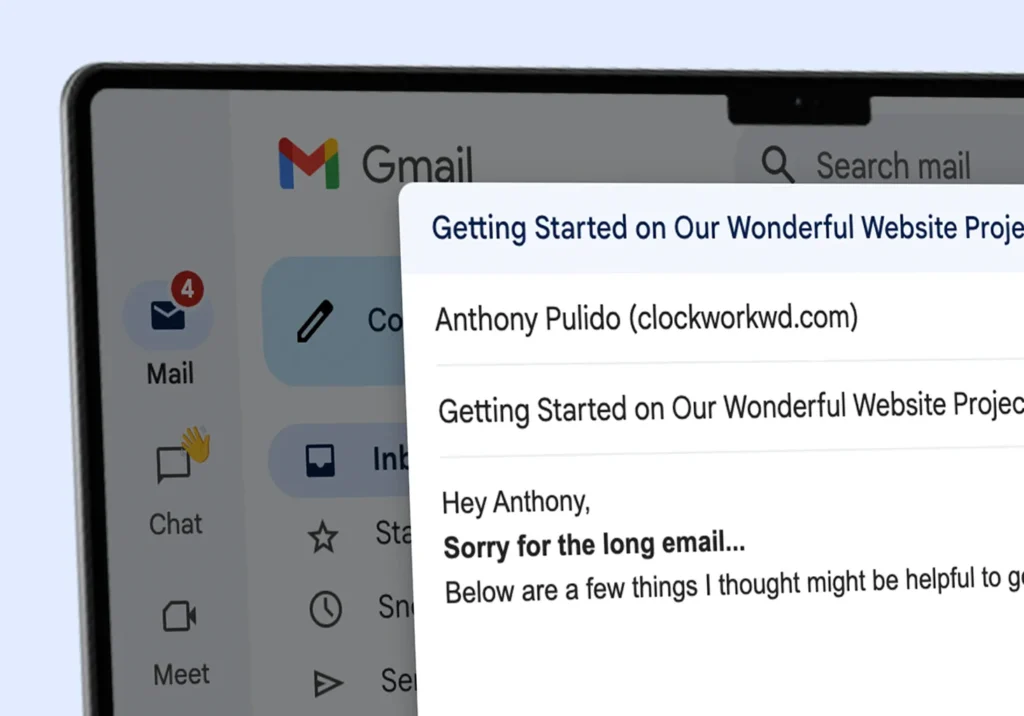After shepherding all kinds of website projects from concept to launch at Clockwork, I’ve learned one consistent truth: success hinges on what happens before the first pixel is designed. Whether we’re building a recipe database for Georgia’s school nutrition program or managing content for a national sorority with 175 chapters, thorough planning prevents costly surprises.
What makes website projects soar and what makes them stumble out of the gate? Let’s go over 10 project management tips that consistently lead to success for our clients:
1. Start with Deep Audience Understanding
When working with Hancock Askew, a century-old accounting firm, their initial goal seemed straightforward: modernize their website. Their real big challenge was making complex financial services accessible and understandable to different audience segments. Individual tax clients and major corporations seeking advisory services alike needed to find what they needed.
Understanding these distinct user needs shaped every decision, from navigation structure to content strategy. Their site now guides each unique visitor type to relevant information with intuitive and logical menu items rather than forcing them to wade through irrelevant content.
2. Build a Realistic Timeline and Budget
A clear timeline isn’t just about picking a launch date. When building the Georgia Department of Education’s Culinary Hub, we found their biggest concern was making sure their complex content structure would work for thousands of school nutrition professionals across the state. Rushing would have meant compromising on essential features like their custom Menu Matrix.
Instead, we broke the project into manageable phases and assigned specific tasks to stakeholders with clear deadlines. Using Teamwork, we tracked milestones, shared assets, and kept everyone accountable through automated reminders. This approach means no compromises on critical functionality and no surprise costs or delays that would require additional approvals from stakeholders. The entire GaDOE team knew exactly what was happening and when, which kept their complex project moving smoothly from concept to launch.
3. Structure Your Content Strategy Early
Don’t overlook your content strategy. Another challenge with GaDOE’s Culinary Hub was organizing thousands of recipes, educational resources, and nutrition guidelines into a coherent framework. The challenge wasn’t just writing a massive volume of content – it was creating a system where busy cafeteria staff could quickly find exactly what they needed.
For their custom Menu Matrix, we developed a taxonomy system for easier access to information. We categorized recipes by meal type, preparation method, and dietary requirements. This early content planning transformed an overwhelming amount of information into an intuitive resource that staff and other key stakeholders actually want to use.
4. Choose the Right Technical Foundation
Selecting your technical foundation means understanding both current and future needs. Take page builders like Elementor and Beaver Builder. They’re both excellent tools with different strengths. For content-rich sites like GaDOE’s Culinary Hub, we tend to use Beaver Builder for its lightweight approach and stability when handling thousands of recipes and resources. For Hancock Askew’s site, Elementor’s advanced styling capabilities helped our web design team create dynamic layouts for their range of service offerings and deep roster of fiscal gurus.
Both page builders bring a lot to the table. Decisions like this are all about matching the tool to your specific needs, team capabilities, and growth plans. These early technical decisions affect everything from page load times to how easily your team can update content years after launch.
5. Build Systems That Scale
Before you start your project, map out your content types: Will you need regularly updated team profiles? Monthly success stories? Annual award announcements? Take our work with Delta Zeta. They came to us with 175 chapters worth of content, plus annual programs for alumni. Instead of creating static pages that required annual upkeep, our custom development team built flexible custom post types (think of it as a stylish template) that their team could easily replicate.
When planning your new website, try to build these patterns into your site architecture from the start. When Delta Zeta needs to add a new chapter or announce next year’s honorees, their team can do it themselves without calling a developer. That’s the power of planning for scale.
6. Establish Clear Project Communication
Website projects involve lots of moving parts and stakeholders. While our team handles the technical aspects, your team reviews designs, writes or reviews content, and makes other key decisions. Weekly check-ins help us stay synchronized. Without clear communication, handoffs between our teams become bottlenecks. Who has final approval? What are your branding guidelines? Who’s your technical point person?
Using a project management tool like Teamwork organizes these workflows and prevents those dreaded “I thought someone else was handling that” moments. However, the tool matters less than the strategy. Clear ownership on both sides keeps your project moving forward.
7. Optimize SEO for Discovery
Our work with SteelMart revealed how proper structure impacts search success. Beyond just keywords, we found that organizing their product information into clear categories and building topic-focused content clusters boosted their organic traffic by 190% in four months. Start your SEO planning early by mapping out your key topics, understanding how your audience searches for your services, and building content that answers their specific questions.
8. Learn from Your Launch
Your first month after launch teaches you more than any pre-launch testing ever could. This is when you see how real users actually interact with your site, often in ways you never expected. After launching Team Novo Nordisk’s new site, we discovered users were naturally moving between race coverage and educational content but not always finding the related resources they wanted. By continuing to work with their team, adjusting the navigation, and adding strategic content connections, we helped visitors more easily explore both the athletic and educational aspects of their overarching mission of diabetes awareness and treatment. Planning for potential additional phases after your website launches can set realistic expectations and help your website grow more successfully over time.
9. Measure What Matters
Success looks different for every website. While overall traffic matters, the real insights come from understanding how visitors interact with your key pages and content. Are they finding your contact forms? Do they explore your case studies? Which service pages keep their attention longest? These are high-level questions you want to keep in mind well after your site goes live. Our team can help you monitor these data points and make site improvement decisions that are informed and bring clear benefit to your customers.
Site speed performance is another crucial metric we track closely. Load times directly impact both user experience and search rankings. When someone clicks on your site, you have seconds to make an impression. Our lightning-fast web hosting & maintenance solutions ensure those first moments count, keeping your site quick and responsive even during traffic spikes.
10. Plan for Ongoing Improvements
Your website is a living thing. We always tell clients to schedule quarterly reviews of their analytics, user feedback, and business goals. What content resonates? Which features need refinement? This regular assessment helps identify opportunities before they become obvious needs. It’s the difference between playing catch-up and staying ahead of your competition.
Plan Well, Build Better
– with Clockwork
Your website deserves tech know-how, smart planning, and customized solutions. Don’t fall into the trap of just rushing to launch something—anything—just to have it online. Taking the time to plan properly now saves you from expensive fixes or complete rebuilds down the road.
Facing website headaches of your own?
Let’s chat about how we can help you solve them.
Frequently Asked Questions About Website Planning & Development
How much does a website project typically cost?
Enterprise WordPress projects usually range from $30,000 to $150,000+, depending on complexity and requirements. For smaller websites with up to 10 pages, including SEO and content writing, our starting price is typically $15k. We have many options for different budgets – we’d love to provide a detailed estimate after understanding your specific needs.
How long does a website project take to complete?
Enterprise-level projects typically take 12-16 weeks from kickoff to launch, while simple websites can be completed in a few weeks. Complex functionality, multiple stakeholders, or large content migrations may extend these timeline estimates. The key is building in enough time for proper planning and testing. Learn more about our full suite of services.
What should I prepare before starting my website project?
Start gathering your brand assets, core content, and key stakeholder input early. We’ll guide you through our proven discovery process, but the clearer you are about what success looks like upfront, the smoother your project will run.
How do you handle ongoing website maintenance?
Our enterprise-grade website hosting and care plans provide comprehensive maintenance, from daily backups to security monitoring and performance optimization. You can choose the level of support that matches your needs, starting at $30/month.
How does a project manager support the web development process?
Your dedicated project manager serves as your main contact and oversees all progress. They make sure deliverables stay on time and on target while coordinating our team of designers, developers, content writers, and SEO specialists.
Can I request changes or updates during the project?
Absolutely! We understand needs evolve. We’ll incorporate your changes and new ideas, discussing any impacts on timeline and budget, then adjust the project plan accordingly.




